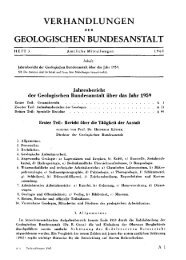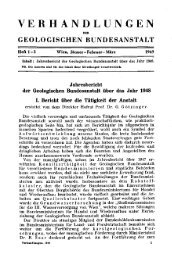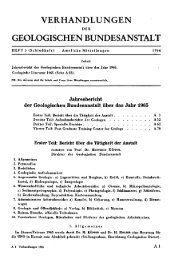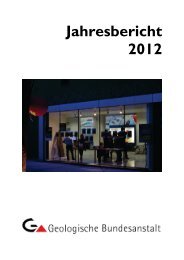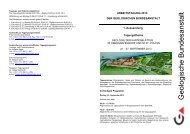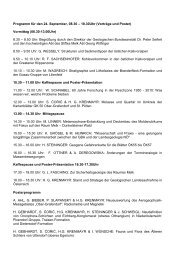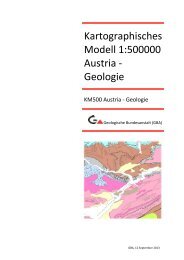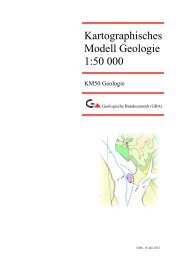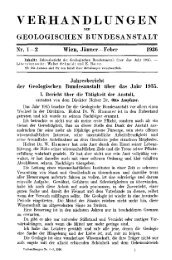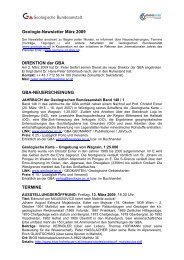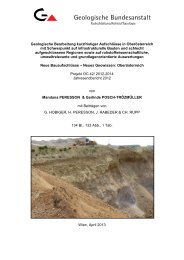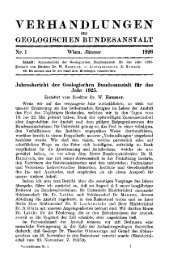Field Trip B TRIASSIC CONODONT LOCALITIES OF THE ...
Field Trip B TRIASSIC CONODONT LOCALITIES OF THE ...
Field Trip B TRIASSIC CONODONT LOCALITIES OF THE ...
You also want an ePaper? Increase the reach of your titles
YUMPU automatically turns print PDFs into web optimized ePapers that Google loves.
Stratigraphy of the Hallstatt region<br />
By<br />
L. KRYSTYN<br />
Introduction<br />
Our excursion deals mainly with the Hallstatt Limestone development and its conodont fauna.<br />
In the Hallstatt facies belt sedimentation started in the Upper Permian which is represented by clastic<br />
and evaporitic rocks known as „Haselgebirge". During the Lower and Middle Triassic shallow wa<br />
ter limestones and dolomites dominated. Sandwiched between these carbonates of mainly Anisian age<br />
and clastic sediments of the Upper Norian/Rhaetian Zlambach Fm. the Hallstatt Lst. is placed. Stratigraphically<br />
the Hallstatt Lst. spans the time from Upper Anisian (Illyrian) to Upper Norian (Sevatian).<br />
The Triassic of the Northern Calcareous Alps is characterized by several main facies zones which from<br />
N to S reflect an increasing open marine environment. The greater part of the Calcareous Alps comprises<br />
thick cyclic shallow water carbonates; in the Lower and uppermost Triassic they can be replaced la<br />
terally by pelitic basinal sediments. Particularly in the Upper Triassic the original transition from lagoonal<br />
deposits (so-called Hauptdolomit-Fazies) to normal saline intertidal Dachstein Lst. with large<br />
„barriere reefs" (Dachstein Reef Lst.) in the south can be traced although most of these blocks were<br />
strongly affected by Alpine nappe tectonics. In this paleogeographic restoration the pelagic fossiliferous<br />
Hallstatt Lst. presumably were located on the outer (?) shelf edge. However, they may have been<br />
deposited on an oceanic crust too as can be inferred from their connection with oceanic basement<br />
rocks (pillow lavas etc.) in the Eastern Tethys realm, e. g., in Greece and Turkey.<br />
Although it has been known for more than a century that the Hallstatt Lst. ranges from the Anisian<br />
to the Norian the representation and extent of the individual stages has been a matter of a long discussion.<br />
For example, as concern the Ladinian Stage, a stratigraphic gap was assumed not only in the last<br />
century but also 10 years ago. The main reason for this conclusion was actually the poor representation<br />
of Ladinian faunas. Also, detailed sections were missing for comparison of the mostly isolated<br />
Hallstatt Limestone occurrences. The ammonite chronology of MOJSISOVICS was thus based more<br />
on phylogenetic considerations and less on biostratigraphic study of certain sections.<br />
The zonal concept of MOJSISOVICS was widely used as a standard until recent times. On the other<br />
side it was very much disputed and even questioned very early (KITTL 1903, p. 16;ARTHABER 1906;<br />
SPENGLER 1919, p. 307). Finally, it was revised by TOZER 1965, 1967 and SILBERLING & TO-<br />
ZER 1968.<br />
Biostratigraphy<br />
The fauna of the Hallstatt Lst. consists of an abundant and diversified cephalopod fauna (orthoceratids,<br />
nautiloids, ammonoids), gastropods, bivalves (in particular of halobiids), brachiopods, crinoids,<br />
and even a few occurrences of corals. For detailed stratigraphic studies ammonoids, conodonts, and<br />
halobiids are most important. The microfauna includes conodonts, foraminiferas, sponge spicules, radiolaria,<br />
floating crinoids and holothurian sclerites.<br />
The megafauna is concentrated in laterally limited thin layers („Lager"). Generally, the Hallstatt<br />
Lst. is more or less poor in fossils with the exception of conodonts which occur in almost every sample.<br />
The megafossil bearing „lenses" are either distinct beds or they are infillings of tectonic fissures which<br />
cut deep into the underlying limestone. According to WENDT 1971 cross cuttings and those which are<br />
parallel to bedding planes can be distinguished, the latter often hardly recognizably.<br />
Individual zones established by MOJSISOVICS were founded on such fissure fillings and thus explain<br />
some of the mistakes of his zonal sequence.<br />
The equivalent of the Anisian Stage is particularly fossiliferous in the surroundings of Hallstatt<br />
(Schreyeralm, Schiechlinghöhe). In that area the cephalopod fauna comprises some 20 genera (MOJ<br />
SISOVICS 1882, DIENER 1901). Middle and Upper Anisian (Binodosus Zone, Trinodosus Zone) and<br />
probably also lowermost Ladinian (ASSERETO 1971) is indicated by representatives of the genera<br />
Acrochordiceras, Paraceratites and Anolcites. In other regions of the Salzkammergut proper megafossils<br />
of Anisian age have not been found at any other place yet.<br />
As far as ammonoids are concerned the situation is comparable m the Ladinian. Due to the „Hornstein"<br />
limestone facies (Grauvioletter Bankkalk) megafossils are completely lacking in the Lower Ladinian.<br />
Upper Ladinian is represented by newly collected and undescribed Protrachyceras pseudoar-<br />
69



